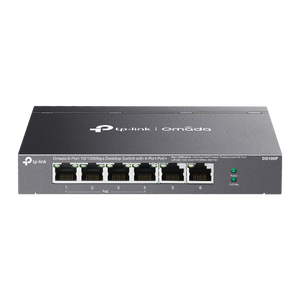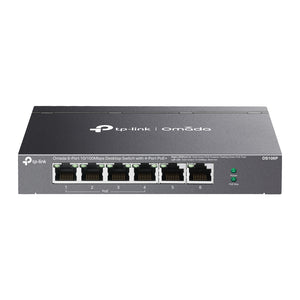PoE Switches deliver power and data over one Ethernet cable, simplifying installation for devices like IP cameras and access points. Omada provides high-power PoE+ and PoE++ models, available in both managed and unmanaged versions from 4 to 48 ports.
-


SG2210P
Omada 8-Port Gigabit Smart PoE+ Switch with 2 SFP Slots, SG2210P
Regular price $114.99Regular price -


ES205GP
Omada 5-Port Gigabit Easy Managed Switch with 4-Port PoE+,ES205GP
Regular price $54.99Regular price -
Sold out


ES220GMP
Omada 20-Port Gigabit Easy Managed Switch with 16-Port PoE+ ES220GMP
Regular price $159.99Regular price -


SG2210MP
Omada 10-Port Gigabit Smart Switch with 8x PoE+, SG2210MP
Regular price $174.99Regular price -
Recommended


SG2210XMP-M2
Omada 8-Port 2.5GBASE-T and 2-Port 10GE SFP+ Smart Switch with 8x PoE+, SG2210XMP-M2
Regular price $349.99Regular price -


SG2008P
Omada 8-Port Gigabit Smart Switch with 4 PoE+, SG2008P
Regular price $94.99Regular price -


SG3218XP-M2
Omada 16-Port 2.5GBASE-T and 2-Port 10GE SFP+ L2+ Managed Switch with 8 x PoE+, SG3218XP-M2
Regular price $499.99Regular price -


SG3428XPP-M2
Omada 24-Port 2.5G ports and 4-Port 10GE SFP+ L2+ Managed Switch with 16 x PoE+ & 8 x PoE++, SG3428XPP-M2
Regular price $719.99Regular price -


ES210GMP
Omada 10-Port Gigabit Easy Managed Switch with 8-Port PoE+, ES210GMP
Regular price $129.99Regular price -


SX3832MPP
Omada 32-Port 10GE L2+ Managed Switch with 24-Port PoE++ SX3832MPP
Regular price $1,999.99Regular price -


SG2005P-PD
Omada 5-Port Gigabit Smart Outdoor Switch with 1x PoE++ in and 4x PoE+ out, IP55 Weatherproof, SG2005P-PD
Regular price $89.99Regular price -


SG2016P
Omada 16-Port Gigabit Smart Switch with 8x PoE+, SG2016P
Regular price $189.99Regular price -


SG2218P
Omada 18-Port PoE+ Gigabit Smart Switch with 2 SFP Slots, SG2218P
Regular price $259.99Regular price -


SG2428LP
Omada 28-Port Gigabit Smart Switch with 16x PoE+, SG2428LP
Regular price $289.99Regular price -


DS106P
Omada 6-Port 10/100 Mbps Desktop Switch with 4x PoE+, DS106P
Regular price $39.99Regular price -


SG3452P
Omada 52-Port Gigabit L2+ Managed Switch with 48x PoE+, SG3452P
Regular price $569.99Regular price

































